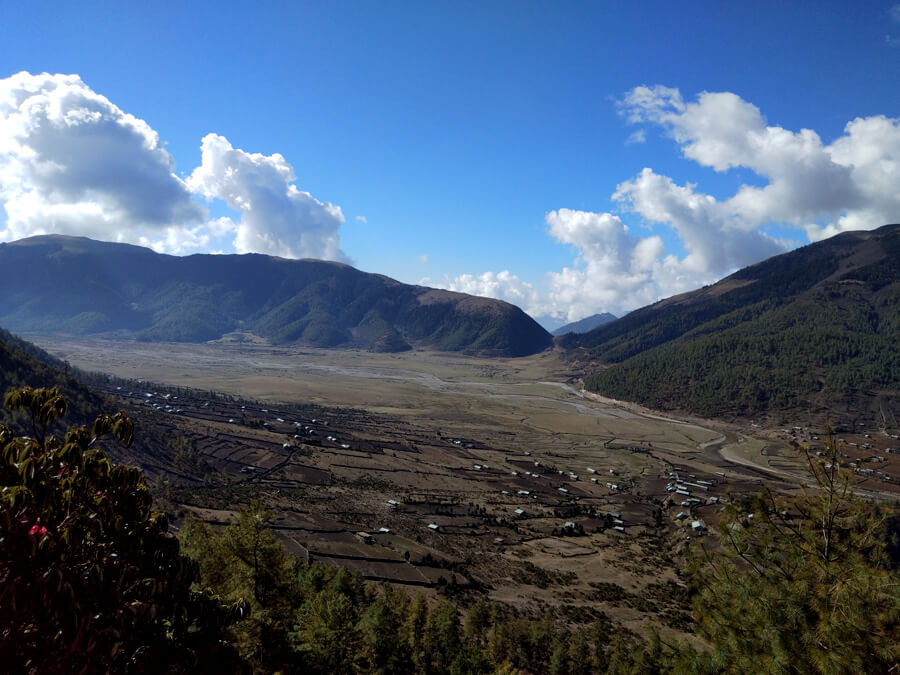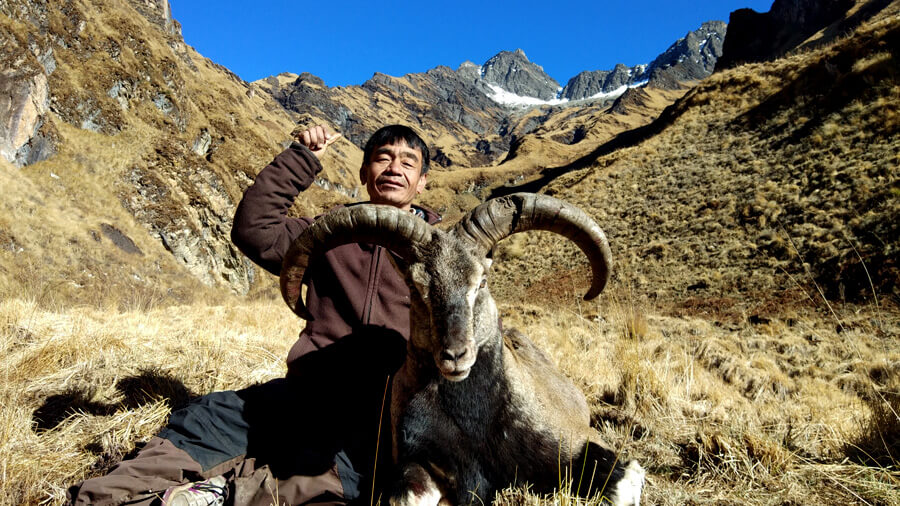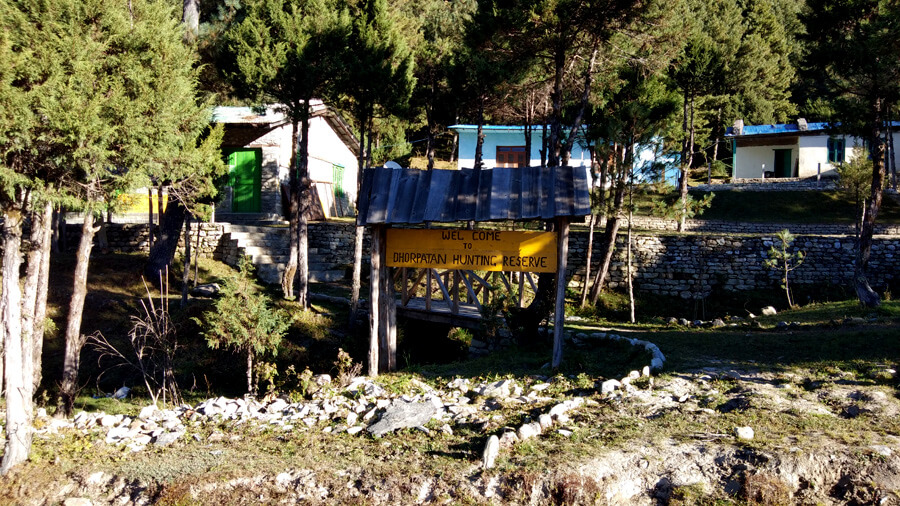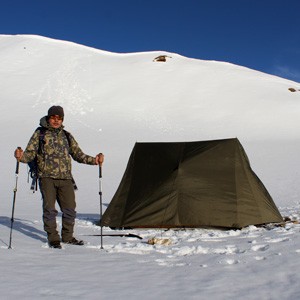What is Trophy Hunting?
Trophy hunting is a sports hunting game, where a human can hunt a selected wild animal in the specified hunting reserve. As the trophy of the game, the hunters are allowed to keep the hunted animal or a part of it (head, skin, antlers, horns, etc). Hunters usually display the trophy in their trophy rooms to show the triumphant hunt. Hunting is the first conservation tool in the world.
Is Trophy Hunting allowed in Nepal?
Yes, trophy hunting is allowed in Nepal under the National Parks and Wildlife Conservation Act, 2029 (1973). You can obtain a license for hunting from the government and are only allowed to hunt within the hunting reserve.
The hunters are allowed to trophy hunt two species- Himalayan Blue Sheep (Naur) and Himalayan Tahr (Jharal) in the Dhorpatan Hunting Reserve that spreads over Rukum, Myagdi, and Baglung districts.
Dhorpatan Hunting Reserve
Established in 1987, Dhorpatan Hunting Reserve is the only hunting reserve of Nepal. Located in western Nepal, the reserve covers an area of 1,325 kilometers square in the Dhaulagiri Himal in the Rukum, Myagdi, and Baglung districts. The altitude of the reserve ranges from 2,850 to 5,500 m (9,350 to 18,040 ft).
The higher point of the Dhorpatan Hunting Reserve remains covered in snow throughout the year. This reserve is home to numerous flowering plants, including 36 endemic species, 18 mammals, 137 species of birds, and 58 vascular plants. You may come across wildlife like musk deer, red panda snow leopard, blue sheep, Himalayan tahr, etc.
Hunting Block
There are seven hunting blocks in the Dhorpatan Hunting Reserve.
- Surtibang Block- only Himalayan Tahr hunt
- Barse Block- Only blue sheep hunt
- Fagune Block- blue sheep and Himalayan Tahr hunt
- Gustang Block- Blue sheep and Himalayan Tahr hunt
- Seng Block- Blue sheep and Himalayan Tahr hunt
- Dogadi Block- Blue sheep and Himalayan Tahr hunt
- Sundaha Block- sheep and Himalayan Tahr hunt

Hunting Season
You can do trophy hunting in Nepal in two seasons: Spring (March to April) and Autumn (October to November). Clear visibility and moderate climate make these two seasons perfect for hunting in the Himalayas.
Blue Sheep Hunting in Nepal
Blue Sheep Hunting is the most sought-after trophy hunting sport in the Himalayas of Nepal. You will get to experience hunting in one of the best hunting grounds. The steep trail and the forested path offer an adventurous venture for challenge lovers.
Our Blue Sheep hunting program lasts for 15 days. You will be assisted by professional hunters and crew during the trip. The crew will take care of building tents and cooking meals.
Below is our blue sheep hunting itinerary.
- Day 01: Arrival in Kathmandu
- Day 02: Fly to Hunting Area
- Day03: Hike to hunting base camp
- Day 13: Back to helicopter camp
- Day 04-12: Hunting starts
- Day 14: Flight to Kathmandu
- Day 15: Your final departure

Himalayan Tahr Hunting in Nepal
Himalayan Tahr hunting is a rewarding and challenging trophy hunting game in the Himalayas. You will be hunting amidst dense forests, hills, and snow-capped mountains. To find the tahr, you will hike on a steep, rugged trail and spend nights in camps in the middle of the forests.
With a mane of a lion and the strut of a bear, Himalayan Tahr is one of the coveted alpine trophies in the world. At Himalayan Wildlife Outfitters, we offer 10 days of Himalayan Tahr hunting venture under the guidance of descendants of great Himalayan hunters and professional crew.
We also offer Combo hunting (Blue Sheep & Himalayan Tahr).
Below is our Himalayan Tahr Hunting itinerary
- Day 01: Arrival in Kathmandu
- Day 02: Kathmandu - Dhorpatan Hunting Reserve by chopper
- Day 03: Hike to Base Camp
- Day 04 -07: Hunting starts
- Day 08: Back to Helicopter spot
- Day 09: Back to Kathmandu
- Day 10: Final departure

Hunting Gear
Overall Hunting in Nepal trip ranges from 10 to 15 days. The accommodation hunting period is camping and meals are cooked by the crew members. Therefore, food, tents, and other essentials are carried by the group.
For gear, you will need a binocular, skinning knife, radio set, rifle Winchester, hiking boots, base layer clothing, Gore Tex jacket, windbreaker pants, gloves, woolen socks, fleece hats, sunglasses, toiletries, sunscreen, first-aid kit, etc.
Hunting Rules
There is a set of rules that hunters have to follow during hunting. Before the beginning of the trip, the hunters will join a briefing session organized by the hunting agency in Nepal they are going with. During the session, you will know all the mandatory rules and regulations.
- Below are some most important rules:
- No hunting when the animal is drinking water
- No hunting of female wildlife or younglings
- No automatic weapons are allowed to be used for the hunt
- No helicopters are allowed in the hunting block
- No hunt before sunrise and after sunset in the mountain
- No allowed artificial sound
Collecting Trophies
Trophy refers to the hunted animal or part of its body. Generally, skin and horns are allowed to collect as a trophy in-game hunting in Nepal.
Trophy Certificate
To get the trophy certificate, the person with the license has to present the trophy to the licensing authority within the given time. The licensing authority will check if the trophy has been properly secured or not and shall decide whether to hand over the trophy and the certificate to the person or not.
Trophy Trade
You are not permitted to supply or sell the trophy without obtaining permission from the designated authority. Likewise, you cannot hand over the title of the trophy or conduct trade without permission.
Trophy Export
If you want to export the trophy from Nepal or import it in the country, then you have to comply with Nepalese law and get a written recommendation from the government of Nepal.

FAQs
How many hunting reserves are there in Nepal?
There is only one hunting reserve in Nepal, Dhorpatan Hunting Reserve. Apart from the hunting reserve, the Nepal government has established 19 other protected areas since 1973 that consist of three wildlife reserves, ten national parks, and six conservation areas.
What can you hunt in the Himalayas?
You can legally hunt the most famous Blue Sheep and Himalayan Tahr in the Himalayas. Likewise, you can also hunt wild boar and muntjac.
Which is the biggest wildlife reserve in Nepal?
The Parsa Wildlife Reserve is the biggest wildlife reserve in Nepal. Back in the days, it used to be the royal hunting reserve, but now it's Nepal's largest wildlife-protected area.
Is hunting legal in Nepal?
Yes, hunting is legal in Nepal. The Nepal government has separated designated areas for the hunters where they can hunt by obtaining permission and license from the government.
How much does a tahr hunt cost?
Himalayan tahrs are the natives of Nepal. It costs around USD 25,000 to USD 30,000 to hunt a tahr in Nepal. You may find a cheaper option in other countries where Himalayan tahr was introduced.






